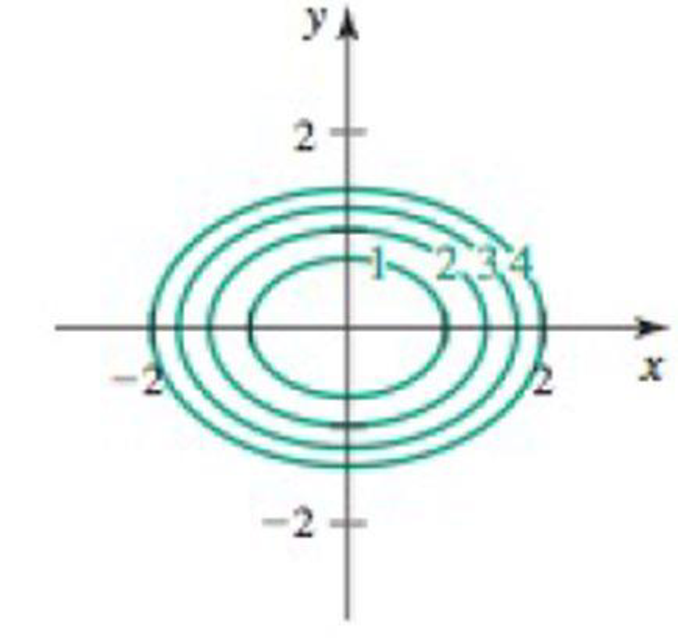
Concept explainers
Equipotential curves Consider the following potential functions and graphs of their equipotential curves.
a. Find the associated gradient field F = ▿ϕ.
b. Show that the
c. Show that the vector field is orthogonal to the equipotential curve at all points (x, y).
d. Sketch two flow curves representing F that are everywhere orthogonal to the equipotential curves.
40. ϕ (x, y) = x2+ 2y2

Want to see the full answer?
Check out a sample textbook solution
Chapter 17 Solutions
Calculus: Early Transcendentals (3rd Edition)
Additional Math Textbook Solutions
Precalculus Enhanced with Graphing Utilities (7th Edition)
Glencoe Math Accelerated, Student Edition
Single Variable Calculus: Early Transcendentals (2nd Edition) - Standalone book
Calculus & Its Applications (14th Edition)
- A net is dipped in a river. Determine the flow rate of water across the net if the velocity vector field for the river is given by = (x - y, z + y + 9, z) and the net is decribed by the equation y = V1-x - z, y 2 0, and oriented in the positive y- direction. (Use symbolic notation and fractions where needed.) V. dS =arrow_forwardMatch each of the following three vector fields to one of the four vector fields graphed below (yes, one graph does not have a match), and then explain your thinking: 1. (a) F(x, y) = (2y, 2.r). Match (circle one): I II III IV (b) F(x, y) = (x², 2y). Match (circle one): I II III IV (c) F(x, y) = (x², y²). Match (circle one): I II III IV (d) Explain your choices. Explanation:arrow_forwardDetermine if the vector fields below are conservative. Find potential functions where possible. (a.) F(x, y) = (2x — sin(x + y²), −2y sin(x + y²)) (b.) F(x, y) = (-y, x) (c.) F(y, z) = (z+y²y+z³)arrow_forward
- Need the sketch of it as wellarrow_forwardLet A be the vector potential and B the magnetic field of the infinite solenoid of radius R. Then { B(r) = A(r) = √x² + y2 is the distance to the z-axis and B is a constant that depends on the current strength I and the spacing of where r = the turns of wire. The vector potential for B is S 0 Incorrect Bk if Jc if r> R r R B(-y, x,0) ifarrow_forwardFourier's Law of heat transfer (or heat conduction) states that the heat flow vector F at a point is proportional to the negative gradient of the temperature: that is, F= -kVT, which means that heat energy flows from hot regions to cold regions. The constant k is called the conductivity, which has metric units of J/m-s-K or W/m-K. A temperature function T for a region D is given below. Find the net outward heat flux SSF•nds= - kff triple integral. Assume that k = 1. T(x,y,z)=110e-x²-y²-2². D is the sphere of radius a centered at the origin. The net outward heat flux across the boundary is. (Type an exact answer, using as needed.) G S VT.n dS across the boundary S of D. It may be easier to use the Divergence Theorem and evaluate aarrow_forwardThe figure shows a vector field F and three paths from P (-3,0) to Q= (3,0). The top and bottom paths T and B comprise a circle, and the middle path M is a line segment. Determine whether the following quantities are positive, negative, or zero, or answer true or false. Be sure you can explain your answers. (Click on graph to enlarge) (a) F dr is ? (b) F- dř is ? F. dr is ? (c) F-dr is 2 () (e) ? v True or False: F- dr () ? v True or False F is a gradient field.arrow_forwardA net is dipped in a river. Determine the flow rate of water across the net if the velocity vector field for the river is given by v = (x-y, z + y + 3, z²) and the net is decribed by the equation y = √1-x²-2², y ≥ 0, and oriented in the positive y- direction. (Use symbolic notation and fractions where needed.)arrow_forwardB8. Advance mathsarrow_forwardarrow_back_iosSEE MORE QUESTIONSarrow_forward_ios
- Algebra & Trigonometry with Analytic GeometryAlgebraISBN:9781133382119Author:SwokowskiPublisher:Cengage
 Algebra and Trigonometry (MindTap Course List)AlgebraISBN:9781305071742Author:James Stewart, Lothar Redlin, Saleem WatsonPublisher:Cengage Learning
Algebra and Trigonometry (MindTap Course List)AlgebraISBN:9781305071742Author:James Stewart, Lothar Redlin, Saleem WatsonPublisher:Cengage Learning

